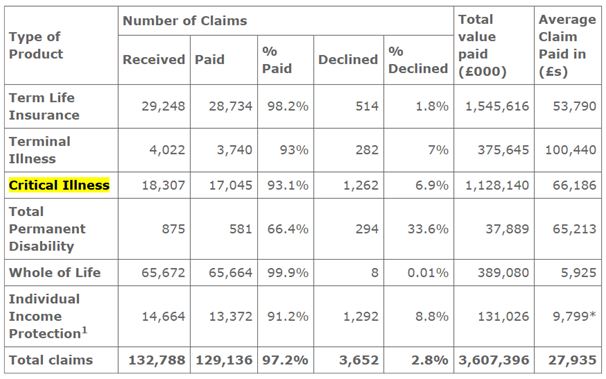Is Stand Alone Critical Illness Cover Worth It?
Every year, half a million women across the UK are diagnosed with breast cancer.

The same illness affects men, too, and it’s estimated that around 400 males who are diagnosed with breast cancer each year.
This is only one of many conditions that critical illness plans are available for to ease the financial worries that follow the emotionally charged diagnosis.
Thankfully, awareness has risen over the years, leading to many cases being diagnosed early, resulting in faster treatments and a much higher survival rate than ever before. That’s the good news.
The bad news is that for those who are diagnosed with any critical illness, the financial ramifications will lead to higher stress levels and money woes, which can impact recovery time.
It’ll also affect the quality of life if you can’t afford home adaptations or your mortgage payments if you need to stay off work beyond what’s covered by your employer’s statutory sick pay (SSP).
Critical Illness Insurance Policies cover more than just cancer. Insurers typically categorise forty to fifty different types of illnesses as critical. Generally speaking, a critical illness is any life-threatening diagnosis requiring urgent medical treatment.
The most prominent you’ll get cover for are heart attacks, strokes and cancer. A definition will accompany the list of illnesses covered by each policy.
Compare Critical Illness Cover From The UK’s Top Providers, Completely Free Service, Save Money Now

You can see an example of that on Legal and General’s “What’s Covered” page here. However, keep in mind that as it is a dynamically developing industry, it’s worth being up-to-date with all the latest life insurance news.
One to note from the definitions on that page is the definition of cancer, which states “excluding less advanced cases”. What that translates to is that they don’t cover early-stage cancer, which, as we already mentioned, the earlier you’re diagnosed, the higher your chance of survival.
Zurich, though, does cover Cancer in situ. Its guide to coverage states, “… an early-stage cancer that has stayed in the same place from where it began and has not spread to neighbouring tissue or organs.”
A prime example of this might be benign skin cancer. May life insurance policies are available for people who have or have had skin cancer in the past.
Every provider has different policies on what they cover as critical. What’s notable, though, is that not all will pay the sum agreed upon, as there are policies that provide partial payment for early diagnosis.
In all cases of critical illness cover paying out – the cover ends. These are one-time policies, meaning they are over once they’ve paid out. You can’t pay to continue the policy once it’s been claimed.
Our advice is to look for a plan that covers at least forty illnesses that the insurer classifies as critical. Any lower, and you’ll likely find a better plan elsewhere.
Always pay attention to the details, though, because not every insurer will cover an early diagnosis if they believe or can prove via medical research statistics that your early diagnosis gives you a high probability of survival and, therefore, categorise your illness as non-life threatening.
Always check the definitions.
What else can you get included?
You shouldn’t settle for the plan with the most illnesses covered, full or partial payments for early diagnosis and certainly never for the cheapest you can find.
When you shop around, you’ll soon find that the insurance markets are competitive, which swings things in your favour.
There are critical illness policies that give added value, some of which can include:
- Early access to medical experts for advice and/or opinions
- Professional counselling services upon receiving a diagnosis
- Family members are included in your policy at no extra cost to you. Remember that once the policy has been claimed, it’s ended. No other family member will be covered under the same policy.
This is also an ideal policy for those who don’t have dependents. Life insurance is ideal for every family, but a life insurance policy may not be a priority for someone single with nobody dependent on them financially.
However, with critical illness cover, it ensures that whatever financial commitments you have can be met in the event you’re unable to work due to a long-term illness being diagnosed.
Life Insurance and Critical Illness Combined
With many life insurance policies, you can add critical illness coverage at an additional cost. Life insurance will only pay out upon the policyholder’s death, regardless of whether a terminal illness has been diagnosed beforehand.
For the sole breadwinners of the household, the additional cover may be worth the financial outlay because if you lose the main income, state benefits might not provide enough money for you to meet the required financial obligations.
If you feel that you would be unable to work for a prolonged period of time or indefinitely, which may require you to sell your home and other material possessions, downsize, or do anything else to get by, it’d be worth considering adding critical illness to your life insurance policy.
If you’re unsure about benefits payable to you when you’re off work sick…
Your employer covers your Statutory Sick Pay for the first 28 weeks, which is taxable income. Lump sum payouts from insurance policies are tax-free. After the 28 weeks, it’ll be state benefits, which often leave people worse off financially.
If you were off work for six months or more, what sort of pressure would your household finances face?
Gone are the Dark Days of Critical Illness Cover
Many people know they could be doing with this level of protection but feel wary because this cover has been associated with bad press.
A while back, Critical Illness plans were notorious because they covered fewer illnesses, and the firms selling them were secretive about the success rates of claims processed.
These days, there are more illnesses included in the plans, and the Association of British Insurers report the statistics of insurance claims processed, and the amount that are unsuccessful.
The table below shows the total statistics for 2015 insurance claims…

Source: ABI (Association of British Insurers)
As you can see, 93.1% of claims are paid successfully. When a claim is made unsuccessfully, it’s usually due to the illness not being covered in the policy or by what insurers refer to as non-disclosure. This is when they feel they issued cover to someone who hasn’t disclosed pertinent information during the application process.
So always be honest about any conditions you’ve had in the past, and most certainly disclose anything that’s required ongoing treatment as it can affect your claim.
Related Reading:
Did The Flagship AIG Critical Illness Plan Just Improve Further?
Critical Illness Cover Explained
Total & Permanent Disability Insurance (TPD)
Latest News From The Life Insurance Industry
Steve Case is a seasoned professional in the UK financial services and insurance industry, with over twenty years of experience. At Insurance Hero, Steve is known for his ability to simplify complex insurance topics, making them accessible to a broad audience. His focus on clear, practical advice and customer service excellence has established him as a respected leader in the field.


